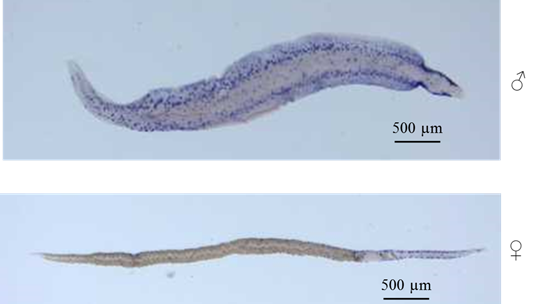GPCRs and Neuropeptids
Even though the majority of genes that are differentially transcribed after pairing occur in females, transcriptomic approaches also revealed a certain number of genes deregulated in males1,2.
Among these pairing-dependent genes are G protein-coupled receptors (GPCRs) of which many are expressed in males and unpaired females3. Surprisingly, these GPCRs become downregulated in females upon pairing3,4. We are interested in the gonad-independent but pairing-influenced role of these GPCRs. In principle, this class of receptors mediates the transfer of an extracellular signal into the cell nucleus. Activation typically involves the interaction with ligands at the extracellular domain. Ligands belong to various groups among which are hormones, neurotransmitters, and peptide hormones. They regulate a variety of cellular functions including growth and differentiation. To unravel the biological significance of GPCR signaling in schistosomes, it is necessary to allocate ligands to their receptors – thus “deorphanizing” the GPCRs.
Aim of this project is to deorphanize selected S. mansoni GPCRs as well as decoding pathways being triggered by these receptors. The focus will be on GPCRs, which are activated by peptide hormones. The first step towards this goal is to employ Yeast-two-hybrid (Y2H) systems. Originally, Y2H was developed to investigate protein-protein interactions (PPI) of cytoplasmic proteins. This groundwork paved avenues for more sophisticated applications to detect PPIs between extracellular neuropeptides and transmembrane receptors (Fig. 1)5,6.
|
|
|---|
|
Fig. 1: Schematic representation of the Y2H system. An interaction of ligand and receptor forces the split & NubG) into close proximity. A ubiquitin specific protease (UBP) recognizes the reconstituted ubiquitin, which is ubiquitin halves (Cub subsequently degraded leading to the release of GAL4. The latter enters the nucleus activating reporter genes to allow detection of interaction3,4.
|
RNA interference (RNAi) experiments of GPCRs and neuropeptides will indicate their physiological and morphological relevance for schistosome biology and help to understand how they exert their function. Some of the characteristics that can be monitored in vitro are pairing stability, egg production, motility, and development. Additional contribution to unravel the function of their encoded proteins can be achieved by the detection of spatial expression patterns of GPCRs and neuropeptide genes by Whole mount In Situ Hybridization (WISH). This method was optimized in the lab of Prof. Jim Collins (Texas University) to visualize RNA molecules in the entire worm (Fig. 2)7,8
 |
|---|
|
Fig 2: A representative micrograph of colorimetric WISH of one neuropeptide precursor mRNA is shown. Depicted are male (♂) and female (♀) worms of S. mansoni. A specific RNA probe was used to visualize neuropeptide precursor transcripts by WISH. Specific structures in both specimen are stained. It can be suggested by the highly ordered structure of these signal that they belong to the nervous system. |
1Lu Z, Sessler F, Holroyd N, Hahnel S, Quack T, Berriman M and Grevelding CG (2016) Schistosome sex matters: a deep view into gonad-specific and pairing-dependent transcriptomes reveals a complex gender interplay. Sci Rep. 6:31150.
2Lu Z, Sessler F, Holroyd N, Hahnel S, Quack T, Berriman M, Grevelding CG (2017) A gene expression atlas of adult Schistosoma mansoni and their gonads. Sci Data. 4:170118.
3Hahnel S, Wheeler N, Lu Z, Wangwiwatsin A, McVeigh P, Maule A, Berriman M, Day T, Ribeiro P and Grevelding CG (2018) Tissue-specific transcriptome analyses provide new insights into GPCR signalling in adult Schistosoma mansoni. PLoS Pathog. 14:e1006718.
4Lu Z, Spänig S, Weth O, Grevelding CG (2019) Males, the wrongly neglected partners of the biologically unprecedented male-female interaction of schistosomes. Front Genet. 10:796.
5Li J, Gao J, Han L, Zhang Y, Guan W, Zhou L, Yu Y and Han W (2016) Development of a membrane-anchored ligand and receptor yeast two-hybrid system for ligand-receptor interaction identification. Sci Rep. 6:35631.
6Weth O, Haeberlein S, Haimann M, Zhang Y and Grevelding CG (2019) Towards deorphanizing G protein-coupled receptors of Schistosoma mansoni using the MALAR yeast two-hybrid system. Parasitology 147(8), 865-873
7Cogswell AA, Collins JJ 3rd, Newmark PA, Williams DL (2011) Whole mount in situ hybridization methodology for Schistosoma mansoni. Mol Biochem Parasitol. 178(1-2):46-50.
8Collins JN, Collins JJ 3rd(2017) Methods for studying the germline of the human parasite Schistosoma mansoni. Methods Mol Biol. 1463:35-47.

